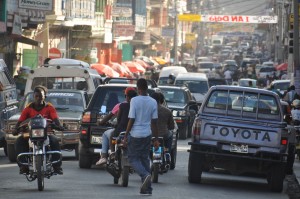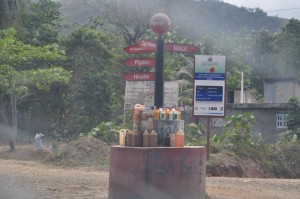Haiti Driving Advice and Car Hire Info
Driving In Haiti
Check your government’s website before driving abroad in Haiti as there may be travel advisories in place for parts of the country. Haiti drives on the right and you can drive using your own photo licence for up to 3 months, after which time you will need a Haitian licence.
Around half of Haiti’s 6000km of highways are paved and the main roads or Route Nationales are generally in fair condition though may have pot holes on certain stretches. The Routes Nationale are –
Route Nationale #1 (RN1) Port-au-Prince to Cap-Haïtien.
Route Nationale #2 (RN2) Port-au-Prince to Les Cayes
Route Nationale #3 (RN3) begins where RN1 heads northwest from Bon Repos and crosses the Plateau Centrale via Mirebalais and to Cap-Haïtien.
Route Nationale #4 (RN4) branches off from RN2 south of Léogâne then climbs and descends the Chaîne de la Selle mountain range to Jacmel.
Route Nationale #5 (RN5) breaks off from RN1 at Gonaïves, heading north and then northwest to Port-de-Paix.
Route Nationale #6 (RN6) branches off from RN3 at Cap-Haïtien and heads southeast toward the Dominican border through Terrier Rouge en route to Ouanaminthe.
Route Nationale #7 (RN7) runs from Les Cayes, going northwest across Haiti’s southern arm to the outskirts of Jérémie.
Route Nationale #8 (RN8) leaves RN1 at Croix-des-Missionsto the Malpasse border crossing with the Dominican Republic.
There are numerous hazards to be encountered driving abroad in Haiti. In Port-Au-Prince, rubble from the earthquake still blocks some side roads and many pavements are now impassable forcing pedestrians onto already crowded roads. Animals will be encountered in the road in both city centres and in the countryside. Cars are supposed to be driven on the right side of the road in Haiti, but few roads have lane indicators and drivers use whichever side of the road is open to them. Traffic is extremely congested in urban areas, and hours-long traffic jams develop throughout the country. Avoid parking your car on the street. Park inside secure car parks at venues such as restaurants, and avoid leaving it alone if possible. When travelling by car, keep doors and windows locked.
Avoid driving in Port au Prince if you can and stay away from dangerous areas such as – Croix-des-Bouquets, Carrefour, Martissant, the port road (Boulevard La Saline), urban route Nationale 1, the airport road (Boulevard Toussaint L’Ouverture) and its adjoining connectors to the New (“American”) Road via Route Nationale 1. The main roads mentioned have been the scene of car jacking and you should never get off a flight and pick a car up at the airport. There are few road signs and its all too easy to stray into the wrong area.
Away from Port Au Prince, driving is less chaotic and roads will be less busy. In my experience, some of the worst driving is likely to be displayed by camionette/tap-tap drivers who will be rushing to reach their destination, in an overcrowded and often non -roadworthy vehicle. Always drive with caution when there are a lot of tap-taps in the area. Roads are often in poor condition and potholes may cause drivers to execute unpredictable and dangerous maneuvers in heavy traffic. Drinking and driving is illegal in Haiti, but people frequently drive after drinking, especially at night and at festival times.
Although Haitian law requires that applicants pass both a written and a driving test to qualify for a driver’s license, many Haitian drivers appear unaware of traffic law or common sense rules of the road. Speed limits are seldom posted and are generally ignored. Speeding is the cause of many fatal traffic accidents in Haiti, as are overloaded vehicles on winding, mountainous roads and vehicles without brakes. Poor maintenance and mechanical failures often cause accidents as well. Drivers should be particularly cautious at night, as unlit vehicles can appear without warning. Right of way is not widely observed in Haiti, and there are few operational traffic lights or traffic signs. It is advisable at most intersections to stop and verify that there is no oncoming traffic even if it appears that you have the right of way. Drivers can be quite aggressive and will seldom yield. Walls built to the edge of roads frequently make it impossible to see around corners, forcing drivers to edge their cars into the road at intersections to check for oncoming traffic.
In addition to vehicles, a variety of other objects may appear on the road in Haiti, such as wooden carts, animals, mechanics working on vehicles parked on the street, and vendors and their wares dipping in and out of traffic lanes. Haiti’s unwritten rule of the road is that any vehicle that breaks down, can be left exactly where it stopped until it can be repaired, even if it creates an enormous backup of traffic. Cars often remain in the roadway for hours or days while often extensive repairs are carried out in-situ.
In summary- driving abroad in Haiti is likely to be a test of nerves. If you attempt it employ the usual rules for driving in the developing world – drive confidently but ultra defensively and always expect the unexpected.
Although I try and keep the information in the site updated as much as possible, in a rapidly moving world, situations can change daily. Therefore please use the site as an approximate guide, and in conjunction with other resources in order to form your view on driving conditions, roads, safety etc.
Haiti Car Rental –
Hertz, Europcar , Budget, Dollar,Avis,Thrifty have branches here though things change often. I had a rental arranged with Europcar in Cap Haitien and when I went to collect the car I found the office had closed down. If you book a car before you go to Haiti, check just before you travel that the reservation is still valid.
We currently have no local car rental partners in Haiti. If you are a local car rental company who would like to feature on DriverAbroad.com please check details on our Partnering page or contact us on ADriverAbroad@Outlook.com
Haiti Self Driving Rules –
By law no rental vehicle can be taken to Dominican Republic.




1 comment